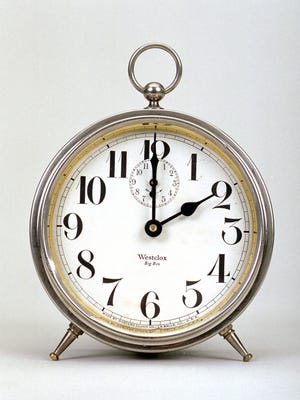When Do You Turn Your Clocks Back in 2018
The annual ritual is nearly upon us.
The end of daylight saving time, which offers an extra hour of sleep, is fast approaching. The seasonal time change will occur on Sunday, Nov. 7.
Daylight saving time ends at 2 a.m. which is the official hour to set all of our clocks back to standard time. That's when local time will instantly become 1 a.m. and people gain an extra hour of time.
The change also brings a downfall, since many people with traditional 9-to-5 office jobs will no longer see much daylight outside the office on weekdays until next spring.
Here are 9 things to know about daylight saving time:
It's not plural
It's daylight saving time not saving's or savings time. It's singular, no matter how people around you say the phrase.
When is it exactly?
Since 2007, daylight saving time begins on the second Sunday of March and ends on the first Sunday of November. Previously, it had started on the last Sunday of April and ended on the last Sunday of October.
Never about the farmers

It was not started to help America's farmers out. According to timeanddate.com, daylight saving time was first used in 1908 by a few hundred Canadians in Thunder Bay, Ontario. But Germany popularized daylight saving time after it first set the clocks forward on April 30, 1916, to save coal during World War I.
Daylight saving time became a national standard in 1966 when President Lyndon B. Johnson signed the Uniform Time Act, which was established as a way to continue to conserve energy. The thinking was if it's light out longer, that's less time you'll need to use the lights in your house.
Do all states observe DST?
Presently, Hawaii and Arizona are the only two U.S. states that do not observe daylight saving time. Neither do the U.S. territories of Puerto Rico, Virgin Islands, Guam, American Samoa and Northern Marina Islands.
Which states want out?

In the past four years, 19 states have passed legislation or resolutions seeking to make Daylight Saving Time the standard time in their states, if Congress takes action, according to the National Conference of State Legislators.
- Those states include:
- Alabama, Georgia, Minnesota, Mississippi and Montana in 2021.
- Georgia, Idaho, Louisiana, Ohio, South Carolina, Utah and Wyoming in 2020.
- Arkansas, Delaware, Maine, Oregon, Tennessee and Washington in 2019.
- Florida in 2018. California voters also authorized a change, but legislative action is pending.
Federal law does not currently allow for full-time DST, but the Sunshine Protection Act of 2021 seeks to change that in Congress.
A bill in the state Legislature calls for Daylight Saving Time to become the year-round standard in New York. It would be contingent on a repeal of the 1966 federal law, and would only take effect if neighboring states went year-round, too.
"Studies show that it is the transition out of Daylight Saving Time, which leads to an increase in car accidents, causes more on-site work incidents, and disrupts the health of all who are subject to this time change," the bill states.
The New York bill hasn't made it out of committee.
What about the rest of the planet?
Daylight Saving Time is now used in over 70 countries worldwide and affects over one billion people every year. The beginning and end dates vary from one country to another.
Next year?
Daylight saving time will return at 2 a.m. on Sunday, March 13, 2022 when we will "spring forward" and lose an hour of sleep.
Phones and smoke alarms
Most phones and computers automatically adjust for the time change, though manual clocks need to be reset. It's also a good time to change the batteries in your smoke alarm.
Scrutiny around daylight saving time
Last year, the American Academy of Sleep Medicine released a statement saying public health and safety would benefit from eliminating daylight saving time.
"Permanent, year-round time is the best choice to most closely match our circadian sleep-wake cycle," Public Safety Committee Vice Chair Dr. M. Adeel Rishi said in a statement. "Daylight saving time results in more darkness in the morning and more light in the evening disrupting the body's natural rhythm."
Additionally, research has shown that cluster headaches are more likely within two week of the time change, and people are more prone to car crashes because of the one less hour of sleep.
Contributing: Delaware News Journal,USA TODAY Network New York, Florida Today, Indianapolis Star and Austin American-Statesman contributed to this report.
When Do You Turn Your Clocks Back in 2018
Source: https://www.democratandchronicle.com/story/news/2021/10/26/daylight-saving-time-2021-when-to-turn-back-your-clock-new-york-dst-things-to-know/6134002001/
0 Response to "When Do You Turn Your Clocks Back in 2018"
Post a Comment